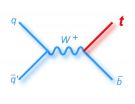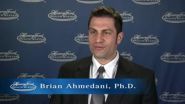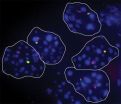(Press-News.org) Scientists on the CDF and DZero experiments at the U.S. Department of Energy's Fermi National Accelerator Laboratory have announced that they have found the final predicted way of creating a top quark, completing a picture of this particle nearly 20 years in the making.
The two collaborations jointly announced on Friday, Feb. 21 that they had observed one of the rarest methods of producing the elementary particle – creating a single top quark through the weak nuclear force, in what is called the "s-channel." For this analysis, scientists from the CDF and DZero collaborations sifted through data from more than 500 trillion proton-antiproton collisions produced by the Tevatron from 2001 to 2011. They identified about 40 particle collisions in which the weak nuclear force produced single top quarks in conjunction with single bottom quarks.
Top quarks are the heaviest and among the most puzzling elementary particles. They weigh even more than the Higgs boson – as much as an atom of gold – and only two machines have ever produced them: Fermilab's Tevatron and the Large Hadron Collider at CERN. There are several ways to produce them, as predicted by the theoretical framework known as the Standard Model, and the most common one was the first one discovered: a collision in which the strong nuclear force creates a pair consisting of a top quark and its antimatter cousin, the anti-top quark.
Collisions that produce a single top quark through the weak nuclear force are rarer, and the process scientists on the Tevatron experiments have just announced is the most challenging of these to detect. This method of producing single top quarks is among the rarest interactions allowed by the laws of physics. The detection of this process was one of the ultimate goals of the Tevatron, which for 25 years was the most powerful particle collider in the world.
"This is an important discovery that provides a valuable addition to the picture of the Standard Model universe," said James Siegrist, DOE Associate Director of Science for High Energy Physics. "It completes a portrait of one of the fundamental particles of our universe, by showing us one of the rarest ways to create them."
Searching for single top quarks is like looking for a needle in billions of haystacks. Only one in every 50 billion Tevatron collisions produced a single s-channel top quark, and the CDF and DZero collaborations only selected a small fraction of those to separate them from background, which is why the number of observed occurrences of this particular channel is so small. However, the statistical significance of the CDF and DZero data exceeds that required to claim a discovery.
"Kudos to the CDF and DZero collaborations for their work in discovering this process," said Saul Gonzalez, program director for the National Science Foundation. "Researchers from around the world, including dozens of universities in the United States, contributed to this important find."
The CDF and DZero experiments first observed particle collisions that created single top quarks through a different process of the weak nuclear force in 2009. This observation was later confirmed by scientists using the Large Hadron Collider.
Scientists from 27 countries collaborated on the Tevatron CDF and DZero experiments and continue to study the reams of data produced during the collider's run, using ever more sophisticated techniques and computing methods.
"I'm pleased that the CDF and DZero collaborations have brought their study of the top quark full circle," said Fermilab Director Nigel Lockyer. "The legacy of the Tevatron is indelible, and this discovery only makes the breadth of that research even more remarkable."
INFORMATION:
Fermilab is America's national laboratory for particle physics research. A U.S. Department of Energy Office of Science laboratory, Fermilab is located near Chicago, Illinois, and operated under contract by the Fermi Research Alliance, LLC. Visit Fermilab's website at http://www.fnal.gov and follow us on Twitter at @FermilabToday.
The DOE Office of Science is the single largest supporter of basic research in the physical sciences in the United States, and is working to address some of the most pressing challenges of our time. For more information, please visit science.energy.gov.
Scientists complete the top quark puzzle
2014-02-24
ELSE PRESS RELEASES FROM THIS DATE:
As hubs for bees and pollinators, flowers may be crucial in disease transmission
2014-02-24
AMHERST, Mass. – Like a kindergarten or a busy airport where cold viruses and other germs circulate freely, flowers are common gathering places where pollinators such as bees and butterflies can pick up fungal, bacterial or viral infections that might be as benign as the sniffles or as debilitating as influenza.
But "almost nothing is known regarding how pathogens of pollinators are transmitted at flowers," postdoctoral researcher Scott McArt and Professor Lynn Adler at the University of Massachusetts Amherst write. "As major hubs of plant-animal interactions throughout ...
Mental health conditions in most suicide victims left undiagnosed at doctor visits
2014-02-24
VIDEO:
The mental health conditions of most people who commit suicide remain undiagnosed, even though many visit a primary care provider or medical specialist in the year before they die, according...
Click here for more information.
DETROIT – The mental health conditions of most people who commit suicide remain undiagnosed, even though many visit a primary care provider or medical specialist in the year before they die, according to a national study led by Henry Ford Health ...
Cancer patients turning to mass media and non-experts for info
2014-02-24
PHILADELPHIA (February 24, 2014) – The increasing use of expensive medical imaging procedures in the U.S. like positron emission tomography (PET) scans is being driven, in part, by patient decisions made after obtaining information from lay media and non-experts, and not from health care providers.
That is the result from a three-year-long analysis of survey data, and is published in the article , "Associations between Cancer-Related Information Seeking and Receiving PET Imaging for Routine Cancer Surveillance – An Analysis of Longitudinal Survey Data," appearing in ...
JCI early table of contents for Feb. 24, 2014
2014-02-24
PPAR-γ agonist reverses cigarette smoke induced emphysema in mice
Pulmonary emphysema results in irreversible lung damage and is most often the result of long term cigarette smoke exposure. Immune cells, such as macrophages and myeloid dendritic cells (mDCs) accumulate in the lungs of smokers with emphysema and release cytokines associated with autoimmune and inflammatory responses. In this issue of the Journal of Clinical Investigation Farrah Kheradmand and colleagues at Baylor University found that peroxisome proliferator activated receptor-γ (PPARγ) ...
Mdm2 suppresses tumors by pulling the plug on glycolysis
2014-02-24
Cancer cells have long been known to have higher rates of the energy-generating metabolic pathway known as glycolysis. This enhanced glycolysis, a phenomenon known as the Warburg effect, is thought to allow cancer cells to survive the oxygen-deficient conditions they experience in the center of solid tumors. A study in The Journal of Cell Biology reveals how damaged cells normally switch off glycolysis as they shut down and shows that defects in this process may contribute to the early stages of tumor development.
Various stresses can cause cells to cease proliferating ...
Two-pronged approach successfully targets DNA synthesis in leukemic cells
2014-02-24
A novel two-pronged strategy targeting DNA synthesis can treat leukemia in mice, according to a study in The Journal of Experimental Medicine.
Current treatments for acute lymphoblastic leukemia (ALL), an aggressive form of blood cancer, include conventional chemotherapy drugs that inhibit DNA synthesis. These drugs are effective but have serious side effects on normal dividing tissues.
In order to replicate, cells must make copies of their DNA, which is made up of building blocks called deoxyribonucleotide triphosphates (dNTPs). Cells can either make dNTPs from scratch ...
Blocking autophagy with malaria drug may help overcome resistance to melanoma BRAF drugs
2014-02-24
PHILADELPHIA— Half of melanoma patients with the BRAF mutation have a positive response to treatment with BRAF inhibitors, but nearly all of those patients develop resistance to the drugs and experience disease progression.
Now, a new preclinical study published online ahead of print in the Journal of Clinical Investigation from Penn Medicine researchers found that in many cases the root of the resistance may lie in a never-before-seen autophagy mechanism induced by the BRAF inhibitors vermurafenib and dabrafenib. Autophagy is a process by which cancer cells recycle ...
Like mom or dad? Some cells randomly express one parent's version of a gene over the other
2014-02-24
Cold Spring Harbor, NY – We are a product of our parents. Maybe you have your mother's large, dark eyes, and you inherited your father's infectious smile. Both parents contribute one copy, or allele, of each gene to their offspring, so that we have two copies of every gene for a given trait – one from mom, the other from dad. In general, both copies of a gene are switched on or off as an embryo develops into an adult. The "switching on" of a gene begins the process of gene expression that ultimately results in the production of a protein.
Occasionally, a cell will arbitrarily ...
Caring for patients with multiple chronic conditions -- New research and future challenges
2014-02-24
Philadelphia, Pa. (February 21, 2014) – The millions of Americans living with more than one chronic disease are at high risk of poor health outcomes, and account for a disproportionate share of health care costs. A special March supplement to Medical Care presents updates from the Agency for Healthcare Research and Quality's (AHRQ) Multiple Chronic Conditions (MCC) Research Network, formed to address knowledge gaps and research challenges in meeting the complex health care needs of this growing population. The journal is published by Lippincott Williams & Wilkins, a part ...
Nearly half of uninsured children live in immigrant families, reports study in Medical Care
2014-02-24
Philadelphia, Pa. (February 21, 2014) – Children from immigrant families now account for 42 percent of uninsured children in the United States, reports a study in the March issue of Medical Care. The journal is published by Lippincott Williams & Wilkins, a part of Wolters Kluwer Health.
More than two-thirds of uninsured children with immigrant parents are US citizens, according to an analysis of nationwide survey data by Eric E. Seiber, PhD, of The Ohio State University College of Public Health, Columbus. He writes, "Initiatives to expand coverage or increase Medicaid ...







